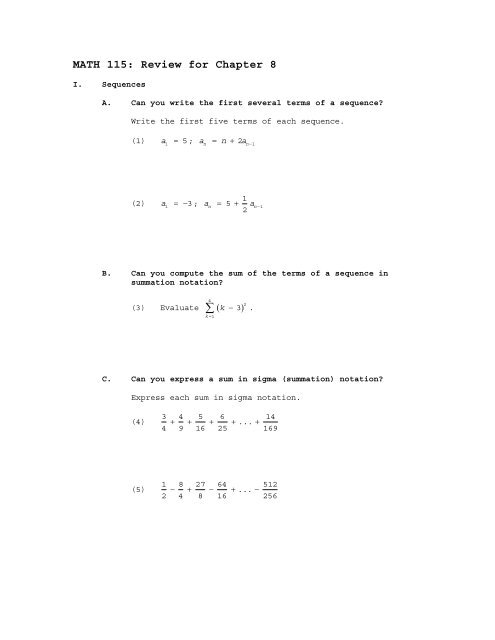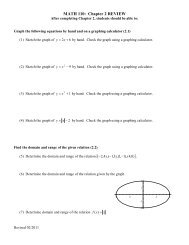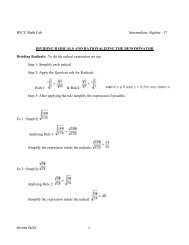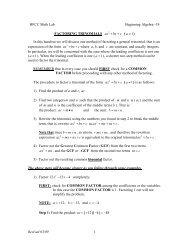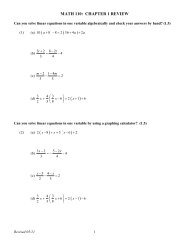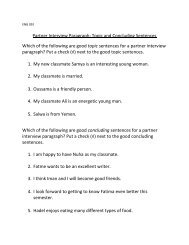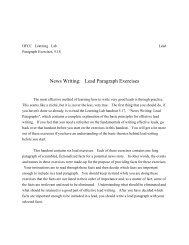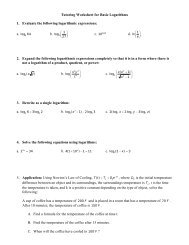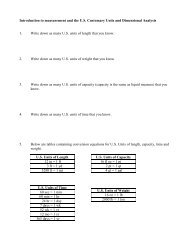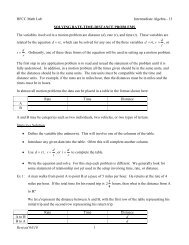Math 115 Chapter 08 Review - The Learning Lab at HFCC
Math 115 Chapter 08 Review - The Learning Lab at HFCC
Math 115 Chapter 08 Review - The Learning Lab at HFCC
Create successful ePaper yourself
Turn your PDF publications into a flip-book with our unique Google optimized e-Paper software.
MATH <strong>115</strong>: <strong>Review</strong> for <strong>Chapter</strong> 8I. SequencesA. Can you write the first several terms of a sequence?Write the first five terms of each sequence.(1) a1= 5 ; an= n + 2a n − 11(2) a1= − 3; an= 5 + an− 12B. Can you compute the sum of the terms of a sequence insumm<strong>at</strong>ion not<strong>at</strong>ion?42∑ .k = 1(3) Evalu<strong>at</strong>e ( k − 3)C. Can you express a sum in sigma (summ<strong>at</strong>ion) not<strong>at</strong>ion?Express each sum in sigma not<strong>at</strong>ion.(4)3 4 5 6 14+ + + + ... +4 9 16 25 169(5)1 8 27 64 512− + − + ... −2 4 8 16 256
D. Can you use the summ<strong>at</strong>ion properties to find the sum of asequence?(6) Evalul<strong>at</strong>e each series.(a)∑ 100 7i− 21i =(b)∑ 25 3ii = 1− 4(c)∑ 7 2i=13i − 4i+ 2II.Arithmetic SequencesA. Can you find a formula for the n th term of an arithmeticsequence?Find a formula for the n thdescribed.term of each arithmetic sequence(7) 5 th term is 23; 11 th term is 53(8) 11 th term is 21; 37 th term is 86
B. Can you find the sum of a finite number of terms ofan arithmetic sequence?Find the sum.(9) 1 + 4 + 7 + ... + ( 3n− 2)(10) 6 + 11 + 16 + ... + 61C. Can you solve applic<strong>at</strong>ion problems involving arithmeticsequences?(11) A brick staircase has a total of 17 steps. <strong>The</strong>bottom step requires 102 bricks. Each successivestep requires 3 fewer bricks than the prior step.How many bricks are required to build the staircase?(12) A se<strong>at</strong>ing area contains 10 se<strong>at</strong>s in the first row.Each other row has 2 more se<strong>at</strong>s than the row in frontof it, and there is a total of 1170 se<strong>at</strong>s.(a)How many rows are there?(b)How many se<strong>at</strong>s are there in the last row?
III. Geometric Sequences; Geometric SeriesA. Can you classify a sequence as arithmetic, geometric, orneither?Classify each sequence as arithmetic, geometric, orneither. Find a formula for the n th term in each case.(13) 5, 9, 13, 17, 21, …(14) 1 2 , 2 5 , 310 , 4 17 , …(15) − 5 , − 8, − 11 , − 14 , …(16) 100, 50, 25, 25 2 , …(17) − 4 , 8, − 16 , 32, − 64 , …(18) 2, 4, 2, 4, 2, 4, …B. Can you find the sum of a finite number of terms of ageometric sequence and an infinite geometric series?Find the sum (if it exists) in each case.(19)3 17 + 7 ⋅ 2 + 7 ⋅ 2 + 7 ⋅ 2 + ... + 7 ⋅ 2 n −
(20)3 207 + 7 ⋅ 2 + 7 ⋅ 2 + 7 ⋅ 2 + ... + 7 ⋅ 2(21) 891 − 297 + 99 − 33 + ...(22) 3 − 9 + 27 − 81 + ...C. Can you solve applic<strong>at</strong>ion problems involving geometricsequences?(23) $120,000 is deposited into an account paying 12%interest (compounded annually), and it is left alonefor 13 years. How much is the investment worth <strong>at</strong>the end of the 13 years?(24) A ball is dropped from a height of 10 meters. Eachtime it strikes the ground it bounces vertically to aheight th<strong>at</strong> is 3 of the preceding height. Find the4total distance the ball will travel if it is allowedto bounce indefinitely.
IV.<strong>The</strong> Binomial <strong>The</strong>oremA. Can you expand a binomial using the Binomial <strong>The</strong>orem?Expand each binomial using the Binomial <strong>The</strong>orem.(25) ( 3x − 2) 4(26) ( ) 53 x +B. Can you find a particular term, or coefficient of a term,in an expansion using the Binomial <strong>The</strong>orem?(27) Find the 3 rd term in the expansion of ( x + 5) 9.(28) Find the 5 th term in the expansion of ( 4x − 3) 10.(29) Find the coefficient of x 4 in the expansion of( 3x + 1) 10.(30) Find the coefficient of x 2 in the expansion of⎛⎜⎝x−122 ⎞⎟ .x ⎠
Answers:(1) 5, 12, 27, 58, 121(2) − 3 , 7 2 , 274 , 67 8 , 14716(3) 6(4) one possibility:(5) one possibility:12∑k = 18∑k = 1k + 2( k + 1)( −1)2k + 1 32k⋅ k(6) (a) 35150(b) 105525(c) 322(7) ( )a = 3 + 5 n − 1 = 5n− 2n5 5 13an= − + n − = n −2 2 2(8) 4 ( 1)(9)3 2 1n − n2 2(10) 402(11) 1326 bricks(12) (a) 30 rows (Reject –39 rows.)(b) 68 se<strong>at</strong>s(13) arithmetic; ( )n(14) neither; an=2n + 1a = 5 + 4 n − 1 = 4n+ 1(15) arithmetic; ( )na = −5 − 3 n − 1 = −3n− 2n(16) geometric;a nn⎛1⎞= 100 ⎜ ⎟⎝ 2 ⎠−1(17) geometric; = − ( − )a n4 2 n(18) neither; a = + ( − )n3 1 n(19) −7 ( 1 − 2 n) or 7 ( 2 n − 1)(20) 14680057−1
(21) 26734(22) No sum exists because r = − 3 = 3 > 1 .(23) $523,619.17(24) 70 meters(25)(26)(27)(28)4 3 281x − 216x + 216x − 96x+ 16+ 15 + 90 + 270 + 405 + 2432 2x x x x x x x7900x669672960x(29) 17010(30) 7920 (<strong>The</strong> fifth term involves x 2 .)


